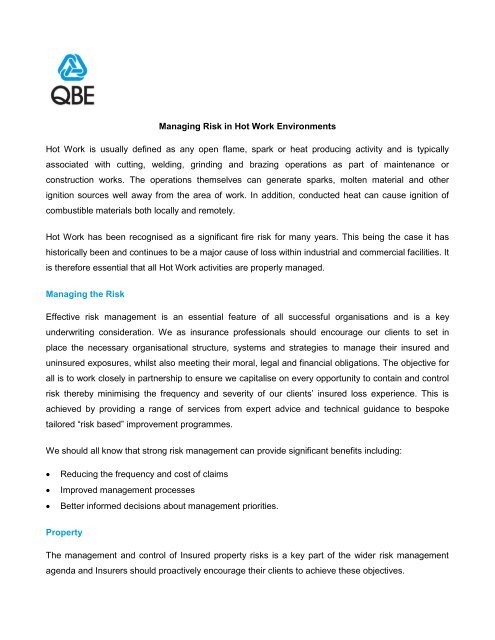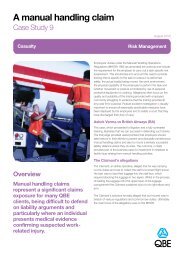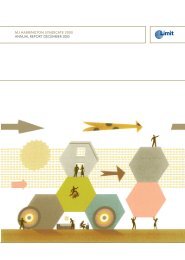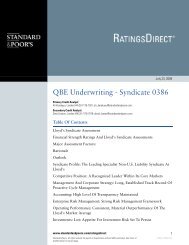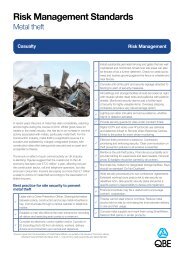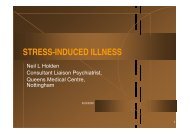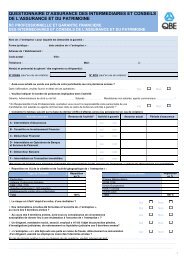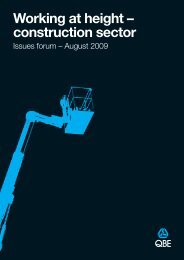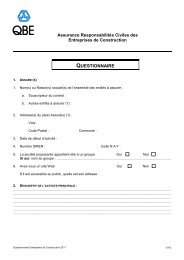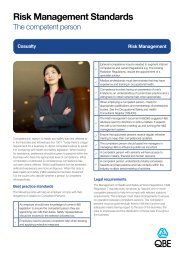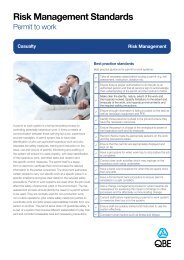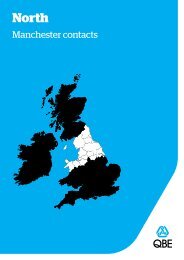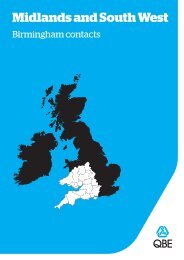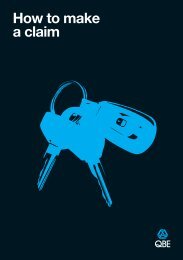Hot Work Risk Management - QBE
Hot Work Risk Management - QBE
Hot Work Risk Management - QBE
You also want an ePaper? Increase the reach of your titles
YUMPU automatically turns print PDFs into web optimized ePapers that Google loves.
Managing <strong>Risk</strong> in <strong>Hot</strong> <strong>Work</strong> Environments<strong>Hot</strong> <strong>Work</strong> is usually defined as any open flame, spark or heat producing activity and is typicallyassociated with cutting, welding, grinding and brazing operations as part of maintenance orconstruction works. The operations themselves can generate sparks, molten material and otherignition sources well away from the area of work. In addition, conducted heat can cause ignition ofcombustible materials both locally and remotely.<strong>Hot</strong> <strong>Work</strong> has been recognised as a significant fire risk for many years. This being the case it hashistorically been and continues to be a major cause of loss within industrial and commercial facilities. Itis therefore essential that all <strong>Hot</strong> <strong>Work</strong> activities are properly managed.Managing the <strong>Risk</strong>Effective risk management is an essential feature of all successful organisations and is a keyunderwriting consideration. We as insurance professionals should encourage our clients to set inplace the necessary organisational structure, systems and strategies to manage their insured anduninsured exposures, whilst also meeting their moral, legal and financial obligations. The objective forall is to work closely in partnership to ensure we capitalise on every opportunity to contain and controlrisk thereby minimising the frequency and severity of our clients‟ insured loss experience. This isachieved by providing a range of services from expert advice and technical guidance to bespoketailored “risk based” improvement programmes.We should all know that strong risk management can provide significant benefits including:Reducing the frequency and cost of claimsImproved management processesBetter informed decisions about management priorities.PropertyThe management and control of Insured property risks is a key part of the wider risk managementagenda and Insurers should proactively encourage their clients to achieve these objectives.
The benefits are:Greater understanding and control of the property and continuity risks that threaten operationsBetter informed decisions about management priorities, major changes and new investmentsGreater appreciation by underwriters of clients‟ risks and the mutual priorities for loss preventionand risk control.Insurers‟ objectives should be to establish a successful working partnership with clients and brokersand to collaborate in achieving mutual objectives. Part of this collaboration would involve a propertyrisk management team reviewing and assessing clients‟ property and continuity risks and the provisionof cost effective, business focused risk control solutions, particularly in businesses where <strong>Hot</strong> <strong>Work</strong> isa necessity. The outcome should be a well developed and fully implemented set of risk controls thatreduce the frequency of loss events and limit the extent of damage and disruption, should a lossoccur.The following encapsulates best practice where <strong>Hot</strong> <strong>Work</strong> activities and exposures exist.Devising a <strong>Hot</strong> <strong>Work</strong> Control ProcedureIdeally <strong>Hot</strong> <strong>Work</strong> should not be carried out and alternative methods of work should be investigated.Should there be no alternative then every effort should be made to relocate the activity to a designatedsafe area well away from buildings and structures or to a properly designed and constructed workshoparea.The decision to carry out <strong>Hot</strong> <strong>Work</strong> when the above criteria cannot be met should be a conscious oneafter all other alternatives have been exhausted. At this stage a formal <strong>Hot</strong> <strong>Work</strong> Control Procedureshould be used.There are numerous hazards associated with <strong>Hot</strong> <strong>Work</strong> in most industrial and commercialenvironments. Where additional factors are present that exacerbate the potential for loss (confinedspaces, potential flammable atmospheres, combustible construction etc) then these should bereflected in the degree of control and level of authority required to allow <strong>Hot</strong> <strong>Work</strong>.All <strong>Hot</strong> <strong>Work</strong> undertaken outside of a designated „safe‟ <strong>Hot</strong> <strong>Work</strong> area or within 15m of buildings,structures or external storage should fall under the <strong>Hot</strong> <strong>Work</strong> Control Procedure.
The procedure should be fully documented, adopted as a company standard and applicable to allemployees, contractors and visitors. As a minimum the procedure should contain the following:Definition of <strong>Hot</strong> <strong>Work</strong>Scope of application of procedureA dedicated permit for the control of <strong>Hot</strong> <strong>Work</strong> activities – <strong>Hot</strong> <strong>Work</strong> PermitTraining requirements for <strong>Hot</strong> <strong>Work</strong> permit issuers, including refresher training timescalesA list of those trained and authorised to issue <strong>Hot</strong> <strong>Work</strong> permitsRequirement for periodic audit of the <strong>Hot</strong> <strong>Work</strong> Control Procedure including live and completed <strong>Hot</strong><strong>Work</strong> permits.<strong>Hot</strong> <strong>Work</strong> PermitsThe use of a dedicated permit to control <strong>Hot</strong> <strong>Work</strong> activities forms part of the <strong>Hot</strong> <strong>Work</strong> ControlProcedure, although on its own it does not constitute an adequate level of control. Many losses haveoccurred where „<strong>Hot</strong> <strong>Work</strong> Permits‟ have been issued but, either these have not been properlycompleted, or the precautions identified have not been properly implemented, or those issuing thepermit do not recognise all the potential hazards.Authority to issue permits should not be implicit within a role designation (i.e. Engineering Supervisor,Health and Safety Advisor) but should be granted following successful completion of appropriatetraining and demonstration of competence.There are numerous examples of <strong>Hot</strong> <strong>Work</strong> permits available from several sources and all tend tocover the majority of required precautions. The key criteria to bear in mind are:Permits should be issued for a specific task in a specific location.Permits should be issued to a named individual and only for that individual to carry out the <strong>Hot</strong><strong>Work</strong>.Permits should not be issued for more than 8 hours.Extensions to permits are acceptable provided all necessary precautions are re-checked and theextension is formally documented.A copy of the issued permit should be available at the place where the work is being carried out. Thisallows those carrying out the work to demonstrate that they have the appropriate permission. Theissued permit also acts as a checklist to allow review of the conditions under which the permit wasissued. Should any of these conditions change then work should be suspended. Resumption of workshould only be undertaken when authorised by the original permit issuer.
Fire WatchA fire watch should be posted during the work. As a minimum this should be one person with a fireextinguisher or hose, but could require additional observers if the work is being done close to pits,trenches or cable trays, or near penetrations through walls or floor or ceilings, or on tall or combustiblestructures. The person doing the <strong>Hot</strong> <strong>Work</strong> should never be allowed to be their own fire watch. Notethat the fire watch should be maintained during breaks in the work such as at refreshment breaks.Statistically the majority of major losses have occurred sometime after the <strong>Hot</strong> <strong>Work</strong> has beencompleted. Smouldering materials may go unnoticed and develop into fires when the area or buildingis unoccupied. A fire watch should always be undertaken during the work and following completion ofthe work. The period of the post-work fire watch should be based on the hazards present. Theminimum post-work fire watch should be continuous for 30 minutes then periodic inspection of thework place and surrounding area (including floors below where the floor is penetrated) for at leastanother 30 minutes. Where there is a significant combustible loading within the building or combustibleconstruction is present, the periodic inspections should be extended to 2 hours or more after the workis completed.To ensure an adequate fire watch can be achieved, <strong>Hot</strong> <strong>Work</strong> should not be allowed within 2 hours ofthe end of the normal shift when operations would normally cease and staff leave for the night.


